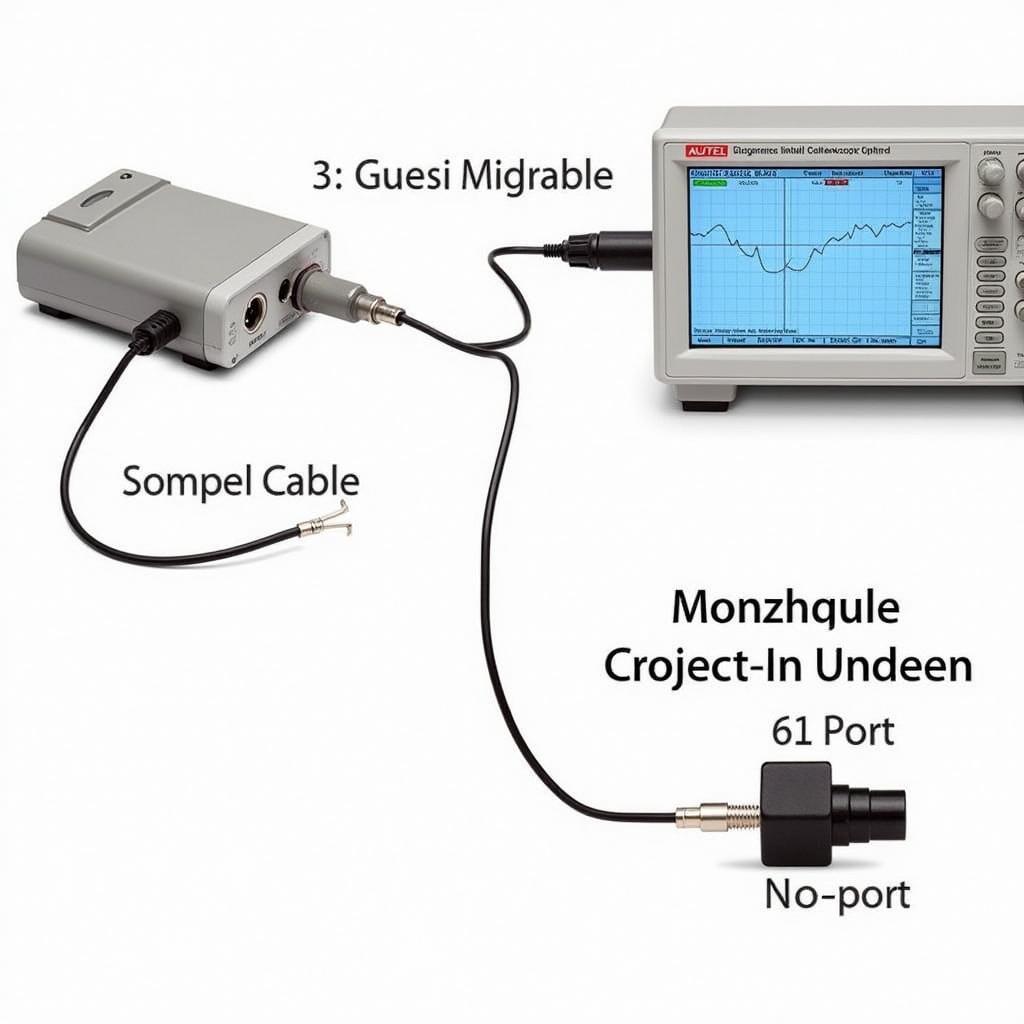Adding a pressure transducer to your Autel oscilloscope opens up a world of diagnostic possibilities. This guide explores how to effectively integrate a pressure transducer with your Autel scope, enhancing your ability to pinpoint issues within complex automotive systems.
Understanding the Power of Pressure Transducers with Autel Oscilloscopes
Pressure transducers are invaluable tools for diagnosing issues related to fuel pressure, oil pressure, transmission pressure, and more. When combined with the power of an Autel oscilloscope, you can visualize pressure fluctuations in real-time, providing crucial insights that traditional diagnostic methods might miss. Autel’s advanced oscilloscope technology allows for precise measurements and waveform analysis, allowing you to identify intermittent problems and pinpoint the root cause of performance issues.
 Connecting an Autel Oscilloscope to a Pressure Transducer
Connecting an Autel Oscilloscope to a Pressure Transducer
Choosing the Right Pressure Transducer for Your Autel Scope
Selecting the correct pressure transducer is crucial for accurate readings and effective diagnostics. Factors to consider include the pressure range, the type of fluid being measured, and the connector type compatibility with your Autel scope. For instance, measuring fuel pressure requires a different transducer than measuring oil pressure, due to the differing pressure ranges and fluid properties. Always consult your Autel oscilloscope’s documentation and autel scope accessories for compatible transducers.
Key Considerations for Pressure Transducer Selection
- Pressure Range: Ensure the transducer’s pressure range encompasses the expected pressures within the system being tested.
- Fluid Compatibility: Verify the transducer is compatible with the type of fluid (e.g., gasoline, oil, transmission fluid) being measured.
- Connector Type: Confirm the transducer’s connector type matches the input on your Autel oscilloscope. Adapters might be needed in some cases.
Connecting and Calibrating the Pressure Transducer
Connecting the pressure transducer to your Autel oscilloscope is typically straightforward. Consult the user manual for specific instructions related to your model. Calibration is essential for accurate measurements. Most Autel oscilloscopes offer built-in calibration procedures for pressure transducers. Ensure you follow these procedures precisely to obtain reliable results.
Step-by-Step Connection Guide
- Connect the pressure transducer to the appropriate port on your Autel oscilloscope.
- Install the transducer into the system being tested.
- Power on the oscilloscope and select the correct channel and settings.
- Calibrate the transducer according to the Autel user manual.
“Proper calibration is the cornerstone of accurate pressure readings. Never skip this step,” advises John Miller, Senior Automotive Diagnostic Technician at Miller’s Auto Repair.
Interpreting Pressure Waveforms on Your Autel Oscilloscope
Once connected and calibrated, the Autel oscilloscope will display the pressure waveform. Analyzing this waveform reveals valuable information about the system’s performance. Look for anomalies like pressure spikes, drops, or oscillations that deviate from normal operating parameters. These anomalies can indicate problems like clogged filters, faulty regulators, or leaks within the system.
Common Pressure Waveform Anomalies
- Pressure Spikes: Can indicate restrictions or blockages in the system.
- Pressure Drops: Might point to leaks or failing pumps.
- Oscillations: Could suggest issues with regulators or control valves.
“Analyzing pressure waveforms is like reading a secret code that reveals hidden problems within the vehicle’s systems,” explains Sarah Johnson, Lead Diagnostic Specialist at Johnson Automotive Solutions.
Conclusion: Unlocking Diagnostic Power with Autel Oscilloscope and Pressure Transducers
Adding a pressure transducer to your Autel oscilloscope unlocks a powerful diagnostic capability, providing detailed insights into pressure-related issues within automotive systems. By understanding how to select, connect, calibrate, and interpret pressure waveforms, you can enhance your diagnostic skills and efficiently pinpoint the root cause of complex automotive problems. Properly using an Autel oscilloscope with a pressure transducer is invaluable for any serious automotive technician.
FAQ:
- What types of pressure can be measured with an Autel oscilloscope and a pressure transducer? (Fuel, oil, transmission, etc.)
- How do I choose the right pressure transducer for my Autel oscilloscope? (Consider pressure range, fluid compatibility, and connector type.)
- How do I calibrate a pressure transducer on my Autel scope? (Refer to the Autel user manual for specific calibration instructions.)
- What do pressure spikes indicate on a waveform? (Potential restrictions or blockages.)
- What do pressure drops suggest on a waveform? (Possible leaks or failing pumps.)
- Where can I find compatible autel scope accessories? (Check DiagXcar’s website.)
- Why is it important to calibrate the pressure transducer? (For accurate and reliable measurements.)
For further assistance, please contact us via WhatsApp: +1(641)206-8880, Email: cardiagtechworkshop@gmail.com or visit us at 276 Reock St, City of Orange, NJ 07050, United States. Our customer service team is available 24/7.


